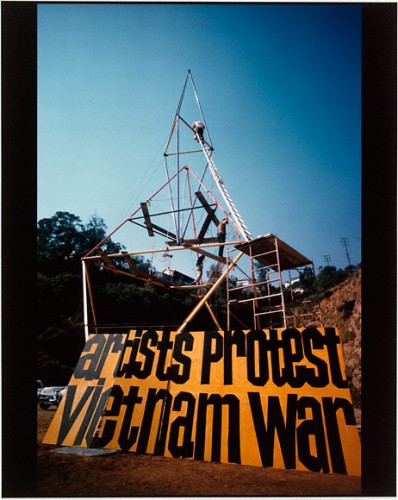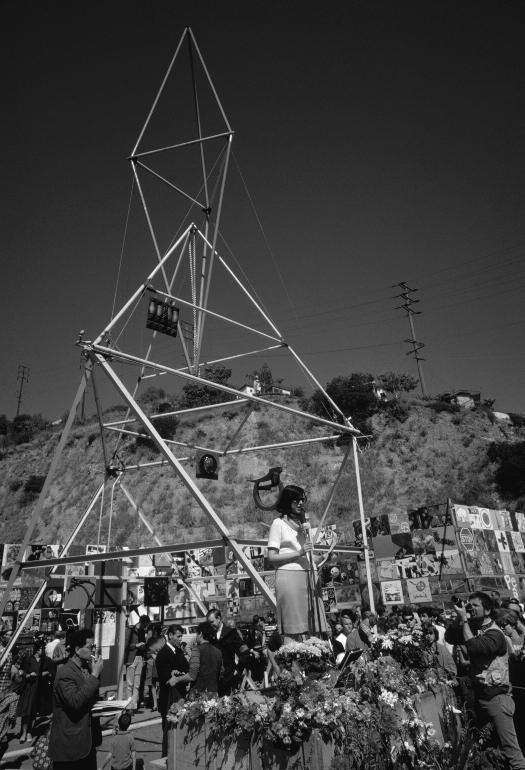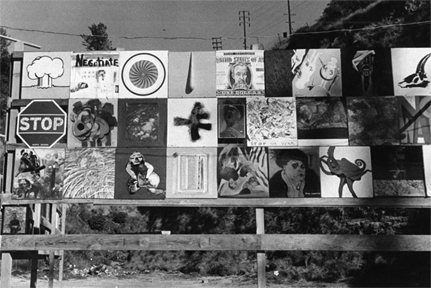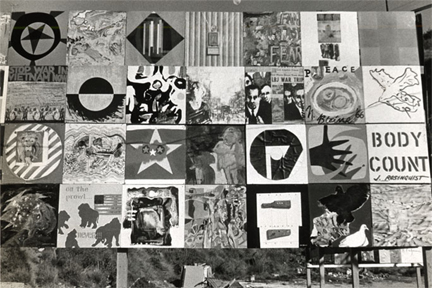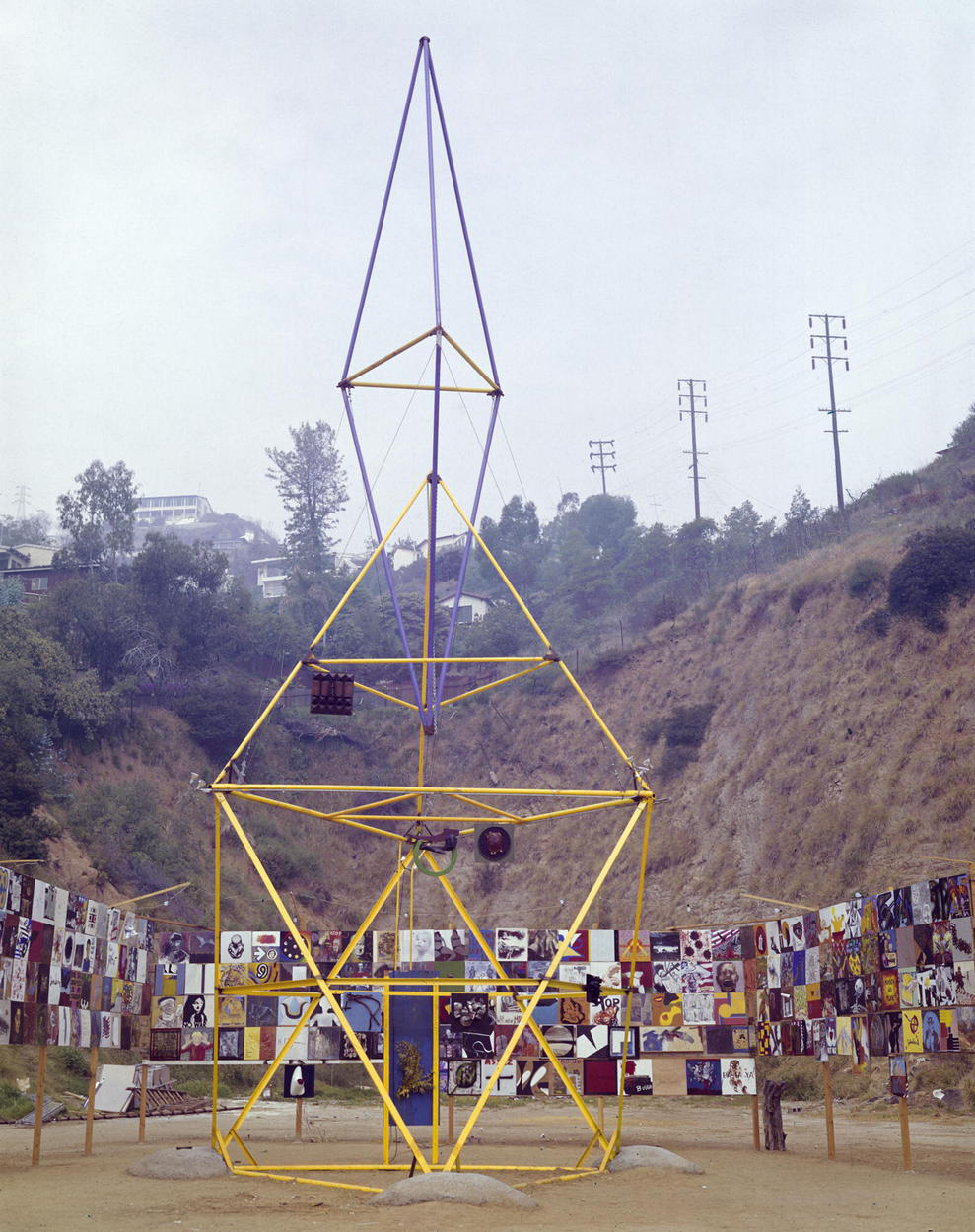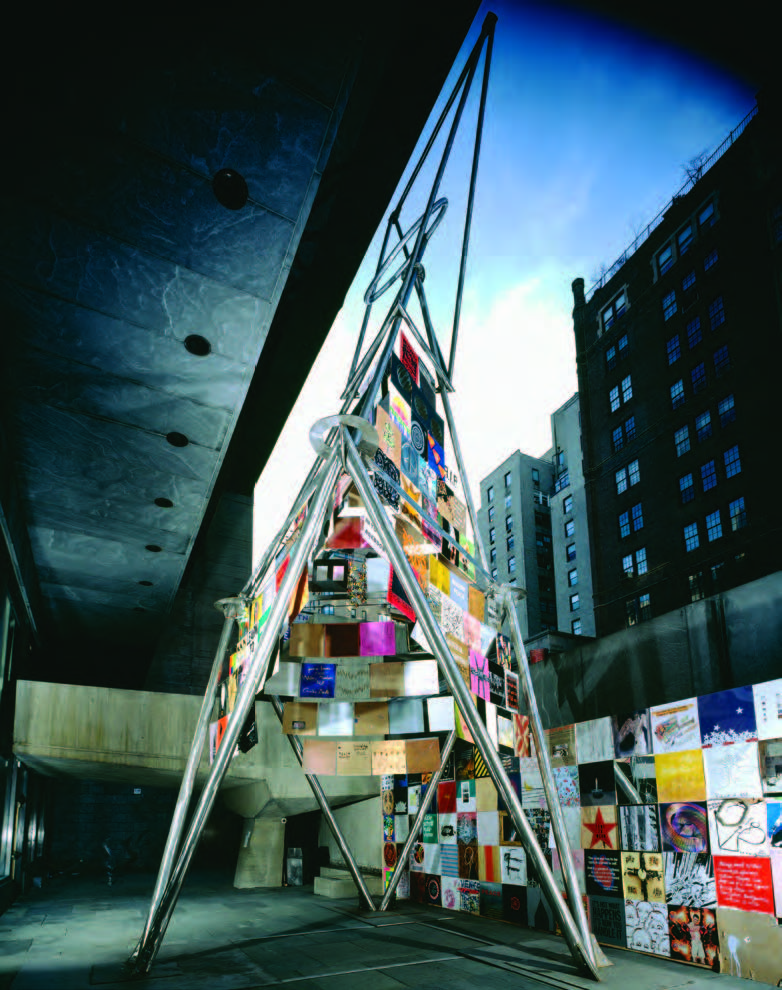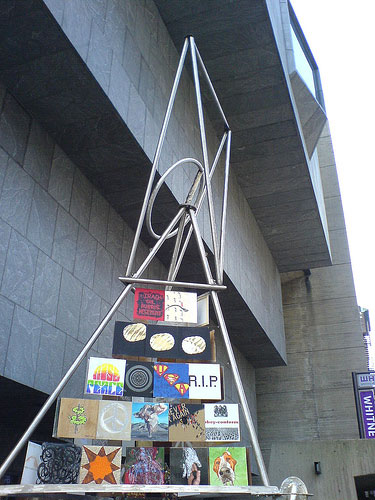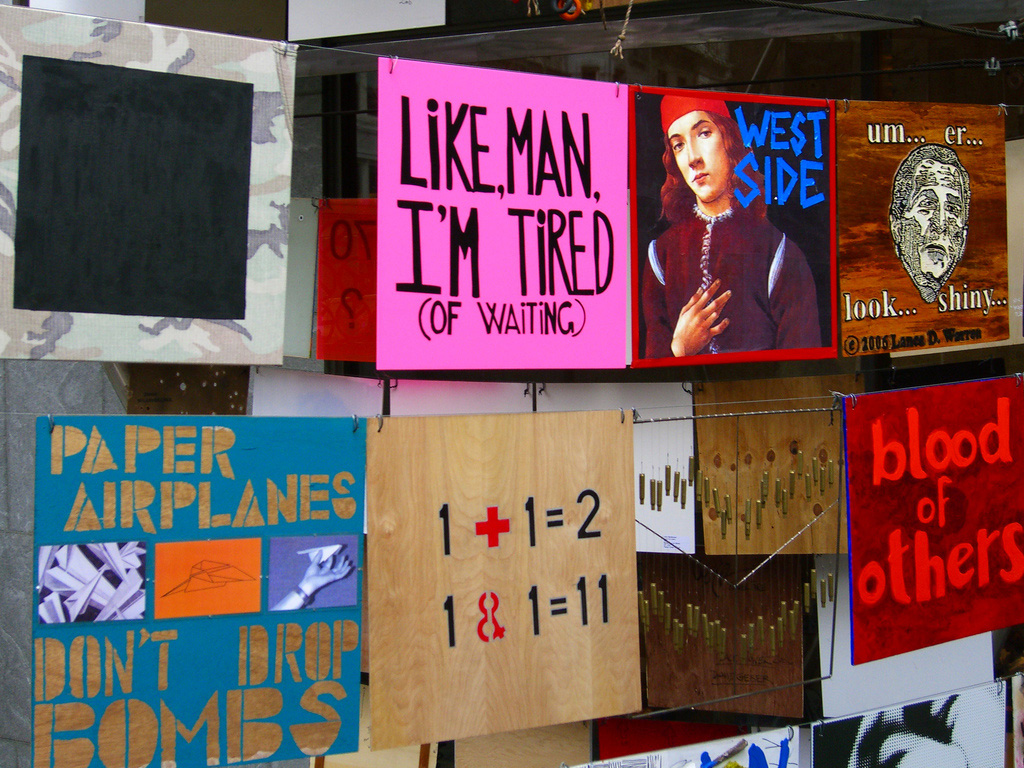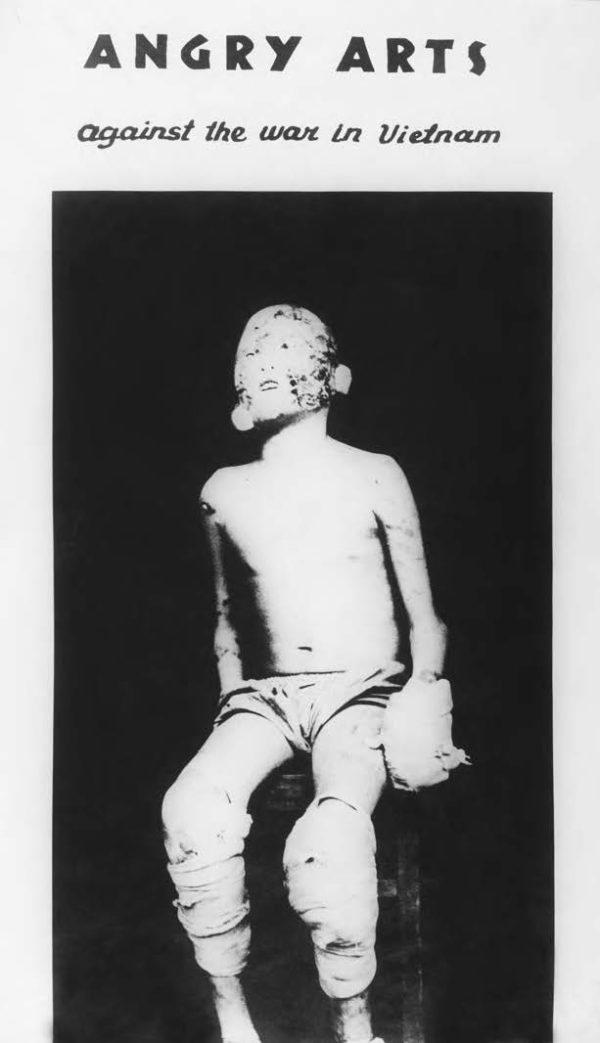Artists’ Tower of Protest
The concept of creating a common, public anti-war artwork occurred to the members of the Artists’ Protest Committee already in 1965. They were hoping that explicit visual criticism of the military conflict in Vietnam will help to spark off a serious public debate about the war. The artists quickly managed to raise a considerable amount of money for the project. The persons who supported the creation of the Peace Tower included Judy Chicago, Robert Rauschenberg and William Copley, to name a few.
The person in charge of the entire undertaking was Irving Petlin who offered to find a plot of land as a site for the installation. He managed to rent for three months a small undeveloped square in the very centre of Los Angeles. To do it, however, he had to keep the real use of the and secret. In mid-1960s in the United States politically engaged art was not respected and protests organized by artists were commonly treated as pranks. Petlin was also responsible for producing a brochure sent to artists from all over the world with information about the project and encouragement to submit anti-war artworks to be displayed on the Artists’ Tower of Protest.
Mark di Suvero, a New York artist known for his anti-war activity, who became a member of the APC in late 1965 was given the job of building the Peace Tower. The central element of the sculpture was a nearly 20-metre tall tower built of iron rods. Its complex structure alluded to the designs of the legendary American architect and inventor Buckminster Fuller. The tower was surrounded by a 30-metre long display space on which anti-war paintings were put up in the form of 60 cm x 60 cm panels.
418 Panels Against War
The request to send in anti-war artworks met with a huge response from the art community. APC received as many as 418 panels, many more than the structure prepared by Mark di Suvero could accommodate therefore some of them had to be hung on the fence around the plot of land. The Peace Tower showed both the works of well-known artists representing different groups and communities, such as Nancy Spero, Roy Liechtenstein, Ad Reinhardt, Eva Hesse, Donald Judd, James Rosenquist, Mark Rothko, Judy Chicago, Robert Motherwell, Elaine de Kooning, Philip Evergood, Alice Neel, the Moses Brothers, Rafael Soyer, Leon Goulb, Rudolf Baranik and Tom Wesselmann, as well as hundreds of works of less known artists and amateurs.
The panels displayed on the Artists’ Tower of Protest were diverse in form. Artists approached the subject of opposition against the war in Vietnam in hundreds of different ways, often employing their individual, signature styles. In the words of Julia Bryan-Wilson:
“The panels […] were aesthetically diverse—some utilized abstract forms; others depicted figurative, well-known anti-war motifs, such as Alice Neel’s skeleton surrounded by flames emblazoned »Stop the War«. They were installed »democratically« that is to say, in no particular order. […] the wall’s expansive visual logic accommodated a cacophony of styles, with panels featuring President Johnson’s face, an appropriated fragment from Picasso’s Guernica, a handwritten signature, and typewritten text pieces alongside more allusive geometric shapes and painted swaths of color. One panel shows a tic-tac-toe game that has resulted in a stalemate and suggests that in war, too, there are no winners. Arranged in a typically modernist grid, the squares, while they shared little formally, attained an overall, quilt like cohesion. Further, the varied designs were corralled together under the hand-lettered proclamation »Artists Protest the Vietnam War« and thus registered as responses to the war regardless of their content.” J. Bryan-Wilson, Art Workers: Radical Practice in the Vietnam War Era, University of California Press, Berkeley 2009, s. 5-6.↩︎
Who Is Afraid of the Peace Tower?
The Artists’ Tower of Protest was officially presented to the public on February 26, 1966. During the opening ceremony speeches were delivered by Susan Sontag and Donald Duncan, a former US army soldier and a fierce opponent of America’s engagement in the conflict in Vietnam. The sculpture-exhibition situated next to La Cienega Boulevard, a street full of art galleries, quickly attracted the attention of the media and of the public who gathered around it. The tower gained the status of the most important public, alternative and non-institutional art exhibition in the United States.
The anti-war and political nature of the Peace Tower also attracted the interest of the advocates of the Vietnam war who quickly demanded dismantling of the installation accusing the artists of anti-state propaganda and hidden support to communism. The owner of the plot of land on which the structure was erected was also furious but despite his best efforts he did not manage to terminate the agreement with the APC before the lapse of the agreed period of three months. During its existence, the Artists’ Tower of Protest was many times an object of physical attacks and had to be guarded 24 hours a day. Many of the attacks happened with a tacit consent of Los Angeles police which also resented the project.
Although members of the APC were hoping that the tower would remain in the public space until the end of the war, due to continuous attacks and clashes with intruders after three months the tower was dismantled. Despite a number of attempts, no museum or institution was interested in taking over the Artists’ Tower of Protest. The artwork was too controversial to become a part of any art collection. In the end, pieces of the structure were distributed among the organizers as keepsakes and the panels wrapped in brown paper were sold as anonymous works at an auction organized by a local pro-peace organization.
Recreation
In 2006, during the New York Whitney Biennale, a Thai artist named Rirkrit Tiravanija decided to recreate an updated version of the legendary Peace Tower. The sculpture recreated after 40 years was intended not only as a tribute to one of the biggest artistic anti-war campaigns in the history of the United States, but also become a manifestation of artists’ protest against American intervention in Iraq. The idea to recreate the tower was mentioned for the first time in 2003 at the time of massive anti-war protests.
Tiravanija invited to his project of the new version of the Artists’ Tower of Protest both Mark di Suvero who built the structure for the new tower and Irving Petlin who once again appealed to artists from all over the world to send in their anti-war works in the form of small panels. Just like in the case of the protest against the war in Vietnam 40 years earlier, the response of the artists invited to join in the collective opposition against the war in Iraq was very strong. Ultimately, close to 300 new panels were hung on the recreated Peace Tower. Some of them were paintings made by persons involved in the creation of the original tower. Other works included those created by the younger generation of American artists and by famous 20th century artists known for their engagement in progressive anti-war movements, such as James Rosenquist, Nancy Spero, Yoko Ono, Hans Haacke, Joha Baldessari, Ethelyn Honig and Alice Zimmermann.
According to critics, Tiravanija’s recreation was a great success and the tower was one of the most interesting artworks presented during the Whitney Biennale in 2006. Although the new version was a 100% exhibition object deprived of the partisan nature and political enthusiasm of the original installation, it showed that 50 years later objection to war was still a strong and popular attitude in the art world. In one of the interviews, Chrissie Iles, a co-curator of Whitney Biennale said:
“The anti-war sentiment among artists has been very strong, it’s what we felt everywhere, whether we were at an artist’s studio doing abstract paintings or whatever. It’s just a general sense of anger that they feel, this sense of things falling apart.” https://newsgrist.typepad.com/underbelly/2006/week9/ [dostęp: 11.01.2019].↩︎
